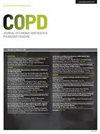Exacerbation Burden in COPD and Occurrence of Mortality in a Cohort of Italian Patients: Results of the Gulp Study
IF 3.1
3区 医学
Q1 Medicine
International Journal of Chronic Obstructive Pulmonary Disease
Pub Date : 2024-03-01
DOI:10.2147/copd.s446636
引用次数: 0
Abstract
Objective: To describe the burden of moderate to severe exacerbations and all-cause mortality; the secondary objectives were to analyze treatment patterns and changes over follow-up.Design: Observational, multicenter, retrospective, cohort study with a three year follow-up period.
Setting: Ten Italian academic secondary- and tertiary-care centers.
Participants: Patients with a confirmed diagnosis of COPD referring to the outpatient clinics of the participating centers were retrospectively recruited.
Primary and Secondary Outcome Measures: Annualized frequency of moderate and severe exacerbations stratified by exacerbation history prior to study enrollment. Patients were classified according to airflow obstruction, GOLD risk categories, and divided in 4 groups: A = no exacerbations; B = 1 moderate exacerbation; C = 1 severe exacerbation; D = ≥ 2 moderate and/or severe exacerbations. Overall all-cause mortality stratified by age, COPD category, and COPD therapy. A logistic regression model assessed the association of clinical characteristics with mortality.
Results: 1111 patients were included (73% males), of which 41.5% had a history of exacerbations. As expected, the proportion of patients experiencing ≥ 1 exacerbation during follow-up increased according to pre-defined study risk categories (B: 79%, C: 84%, D: 97.4%). Overall, by the end of follow-up, 45.5% of patients without a history of exacerbation experienced an exacerbation (31% of which severe), and 13% died. Deceased patients were significantly older, more obstructed and hyperinflated, and more frequently active smokers compared with survivors. Severe exacerbations were more frequent in patients that died (23.5%, vs 10.2%; p-value: 0.002). Chronic heart failure and ischemic heart disease were the only comorbidities associated with a higher odds ratio (OR) for death (OR: 2.2, p-value: 0.001; and OR: 1.9, p-value: 0.007). Treatment patterns were similar in patients that died and survivors.
Conclusion: Patients with a low exacerbation risk are exposed to a significant future risk of moderate/severe exacerbations. Real life data confirm the strong association between mortality and cardiovascular comorbidities in COPD.
Keywords: pulmonary disease chronic obstructive, heart failure, ischaemic heart disease, respiratory medicine, public health
意大利患者队列中慢性阻塞性肺病的恶化负担和死亡率:Gulp 研究结果
目的描述中度至重度病情加重的负担和全因死亡率;次要目标是分析随访期间的治疗模式和变化:观察性、多中心、回顾性、队列研究,随访三年:十家意大利学术性二级和三级医疗中心:主要和次要结果指标:中度和重度病情恶化的年化频率,根据患者入组前的病情恶化史进行分层。根据气流阻塞和 GOLD 风险类别对患者进行分类,并分为 4 组:A = 无加重;B = 1 次中度加重;C = 1 次重度加重;D = ≥ 2 次中度和/或重度加重。按年龄、慢性阻塞性肺病类别和慢性阻塞性肺病治疗分层的全因死亡率。逻辑回归模型评估了临床特征与死亡率的关系:共纳入 1111 名患者(73% 为男性),其中 41.5% 有病情加重史。正如预期的那样,根据预先确定的研究风险类别,在随访期间病情加重≥1次的患者比例有所增加(B:79%;C:84%;D:97.4%)。总体而言,在随访结束时,45.5%无病情加重史的患者出现了病情加重(其中31%病情严重),13%死亡。与存活者相比,死亡患者的年龄明显偏大,阻塞和充气过度的情况更多,而且更经常积极吸烟。死亡患者中严重病情恶化的比例更高(23.5% 对 10.2%;P 值:0.002)。慢性心力衰竭和缺血性心脏病是唯一与较高死亡几率(OR)相关的合并症(OR:2.2,P 值:0.001;OR:1.9,P 值:0.007)。死亡患者和幸存者的治疗模式相似:结论:病情恶化风险较低的患者未来面临中度/重度病情恶化的巨大风险。现实生活中的数据证实,慢性阻塞性肺疾病患者的死亡率与心血管合并症之间存在密切联系。 关键词:慢性阻塞性肺疾病;心力衰竭;缺血性心脏病;呼吸内科;公共卫生
本文章由计算机程序翻译,如有差异,请以英文原文为准。
求助全文
约1分钟内获得全文
求助全文
来源期刊

International Journal of Chronic Obstructive Pulmonary Disease
RESPIRATORY SYSTEM-
CiteScore
5.10
自引率
10.70%
发文量
372
审稿时长
16 weeks
期刊介绍:
An international, peer-reviewed journal of therapeutics and pharmacology focusing on concise rapid reporting of clinical studies and reviews in COPD. Special focus will be given to the pathophysiological processes underlying the disease, intervention programs, patient focused education, and self management protocols. This journal is directed at specialists and healthcare professionals
 求助内容:
求助内容: 应助结果提醒方式:
应助结果提醒方式:


